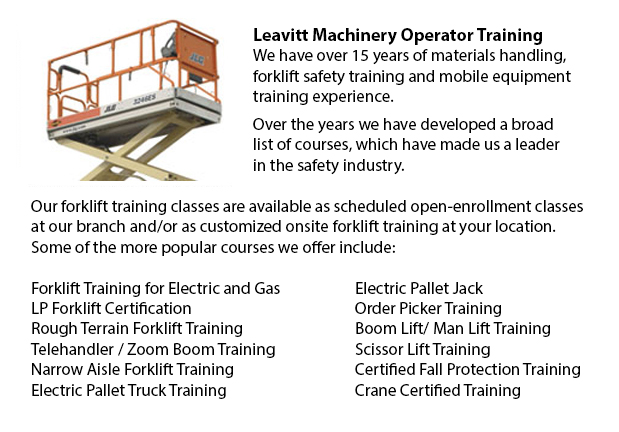
Kamloops Scissor Lift Certification - Many worksites and tradespeople like for example masons, iron workers and welders utilize scissor lift platforms in order to help them reach elevated work places. The operation of a scissor lift is normally secondary to their trade. Hence, it is essential that all platform operators be trained correctly and licensed. Lift manufacturers, regulators and industry work together to ensure that operators are trained in the safe utilization of work platforms.
Scissor lift work platforms are otherwise referred to as manlifts or AWPs. These work machines are somewhat simple to operate and offer a steady work setting, then again they do have risks as they lift people to heights. The following are several important safety issues common to AWPs:
To be able to protect those working around work platforms from accidental power discharge because of close working proximities to wires and power lines, there is a minimum safe approach distance (also referred to as MSAD). Voltage could arc across the air and cause injury to personnel on a work platform if MSAD is not observed.
To guarantee maximum stability, caution must be taken when lowering the work platform. Moving the load towards the turntable, the boom should be retracted. This will help maintain stability when the -platform is lowered.
The rules about tie offs do not mandate people working on a scissor lift to tie themselves off. Several organizations will however, need their personnel to tie off in their employer guidelines, job-specific risk assessments or local regulations. The anchorage provided by the manufacturer is the only safe anchorage to which harness and lanyard combinations must be connected.
Observe the maximum slope rating and do not exceed it. A grade can be measured by laying a straight edge or board on the slope. After that, a carpenter's level can be placed on the straight edge and raised until the end is level. By measuring the distance to the ground and dividing the rise by the length of the straight edge, then multiplying by 100, the per cent slope could be determined.
A typical walk-around inspection needs to be done to determine if the unit is mechanically safe. A location assessment determines if the work area is safe. This is essential specially on changing construction locations due to the possibility of obstacles, contact with power lines and unimproved surfaces. A function test must be performed. If the unit is used correctly and safely and proper shutdown measures are followed, the chances of accidents are really reduced.
-
Kamloops Counterbalance Forklift Training
Kamloops Counterbalance Forklift Training - Counterbalance Forklift Training courses are always in high demand. The Counterbalance forklift is a forklift which is made with a weight which counters the balance, equally spreading the weight of the load... More -
Kamloops Manlift Certification
Kamloops Manlift Certification - The Manlifts and Elevated Platforms program offers training on the rules, regulations and proper application of safe operating measures and work practices included in daily activities for people who work making use of... More -
Kamloops Boom Lift Training
Kamloops Boom Lift Training - Elevated work platforms, likewise referred to as aerial platforms, allow workers to carry out tasks at heights that will otherwise be not reachable. There are various styles of lifts designed for different site applicati... More -
Operator Safety Certification | Re-Qualification Certification | In-House Instructor Certification in Kamloops
Forklifts are used in just about all industrial construction sites and in warehouse operations and in boat yards. The reach feature of a lift truck is a vital component used in several applications like for instance when a shelving system is being us... More -
Kamloops Manlift Safety Training
Kamloops Manlift Safety Training - It is essential for competent Manlift operators to be aware of the connected dangers that come with particular kinds of scissor lifts. They must be able to operate the scissor lift in a way that protects not only th... More -
Kamloops Crane Training Schools
Kamloops Crane Training Schools - We have designed several programs for Mobile Crane Operation at our Crane Training Schools. These programs are recommended for the experienced operator who requires certification or re-certification, and for inexperi... More -
Skid Steer Loader Certification in Kamloops
The engine powered skid-steer loader consists of a rigid and small frame, outfitted together with lift arms which could attach to a lot of industrial attachments and tools to perform several labor saving jobs. Typically, skid-steer loaders are four-w... More -
Kamloops Heavy Equipment License
Kamloops Heavy Equipment License - A heavy equipment license could be acquired by taking a certification and preparation course at a private training school or a vocational school. This license would qualify you to operate various types of heavy mach... More

Forklift Certification Kamloops
TOLL FREE: 1-888-254-6157
Kamloops, British Columbia
forkliftcertificationkamloops.com/
Email Us
About Us


